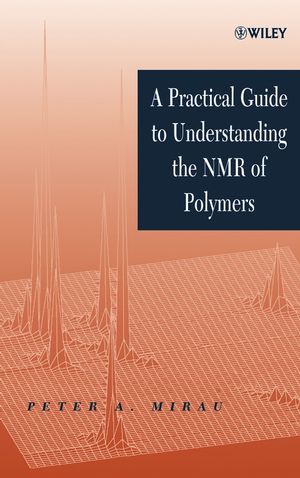A Practical Guide to Understanding the NMR of PolymersISBN: 978-0-471-37123-6
Hardcover
418 pages
December 2004
 This is a Print-on-Demand title. It will be printed specifically to fill your order. Please allow an additional 10-15 days delivery time. The book is not returnable.
|
||||||
1. Introduction to NMR.
1.1 Introduction.
1.2 Basic Principles of NMR.
1.2.1 Introduction.
1.2.2 Magnetic Resonance.
1.2.3 The Rotation Reference Frame.
1.2.4 The Bloch Equations.
1.2.5 Pulsed NMR.
1.2.6 The Fourier Transform.
1.2.7 The Product Operator Formalism.
1.3 Chemical Shifts and Polymer Structure.
1.3.1 Molecular Structure and Chemical Shifts.
1.3.2 Proton Chemical Shifts.
1.3.3 Carbon Chemical Shifts.
1.3.4 Other Nuclei.
1.4 Spin-Spin Coupling.
1.4.1 Introductions.
1.4.2 Nomenclature for Spin-Spin Coupling.
1.4.3 Spin-Spin Coupling Patterns.
1.4.4 Proton-Proton Coupling.
1.4.5 Proton-Carbon Coupling.
1.4.6 Other Nuclei.
1.4.7 Homonuclear Couplings in Insensitive Nuclei.
1.5 NMR Relaxation.
1.5.1 Introduction.
1.5.2 Relaxation Mechanisms.
1.5.3 Spin-Lattice Relaxation.
1.5.4 Spin-Spin Relaxation.
1.5.5 The Nuclear Overhauser Effect.
1.6 Solid State NMR.
1.6.1 Chemical Shift Anisotropy.
1.6.2 Magic-Angle Sample Spinning.
1.6.3 Dipolar Broadening and Decoupling.
1.6.4 Cross Polarization.
1.6.5 Quadrupolar NMR.
1.7 Multidimensional NMR.
1.7.1 Magnetization Transfer in nD NMR.
1.7.2 Solution 2D NMR Experiments.
1.7.3 Solid-State 2D NMR Experiments.
2. Experimental Methods.
2.1 Introduction.
2.2 The NMR Spectrometer.
2.2.1 The Magnet.
2.2.2 Shim Coils.
2.2.3 RF Console.
2.2.4 NMR Probes.
2.2.5 Computer.
2.3 Tuning the NMR Spectrometer.
2.3.1 Adjusting the Homogeneity.
2.3.2 Adjusting the Gain.
2.3.3 Tuning the Probe.
2.3.4 Adjusting the Pulse Widths.
2.4 Solution NMR Methods.
2.4.1 Sample Preparation.
2.4.2 Data Acquisition.
2.4.3 Decoupling.
2.4.4 Data Processing.
2.4.5 Quantitative NMR.
2.4.6 Sensitivity Enhancement.
2.4.7 Spectra Editing.
2.5 Solid-State NMR Methods.
2.5.1 Magic-Angle Sample Spinning.
2.5.2 Gross Polarization.
2.5.3 Decoupling.
2.5.4 Wideline NMR.
2.5.5 Solid-State Proton NMR.
2.6 NMR Relaxation.
2.6.1 NMR Relaxation in Solution.
2.6.2 Solid-State NMR Relaxation.
2.7 Multidimensional NMR.
2.7.1 Data Acquisition.
2.7.2 Data Processing.
3. The Solution Characterization of Polymers.
3.1 Introduction.
3.1.1 Polymer Microstructure.
3.1.2 Spectral Assignments in Polymers.
3.2 Stereochemical Characterization of Polymers.
3.2.1 The Observation of Stereochemical Isomerism.
3.2.2 Resonance Assignments for Stereosequences.
3.3 Regioisomerism in Polymers.
3.4 Defects in Polymers.
3.4.1 Branching.
3.4.2 Endgroups.
3.5 Polymer Chain Architecture.
3.6 Copolymer Characterization.
3.6.1 Random Copolymers.
3.6.2 Alternating Copolymers.
3.6.3 Block Copolymers.
3.7 The Solution Structure of Polymers.
3.7.1 Polymer Chain Conformation.
3.7.2 Intermolecular Interactions in Polymers.
4. The Solid-State NMR of Polymers.
4.1 Introduction.
4.2 Chain Conformation in Polymers.
4.2.1 Semicrystalline Polymers.
4.2.2 Amorphous Polymers.
4.2.3 Elastomers.
4.2.4 Reactivity and Curing in Polymers.
4.3 Structure and Morphology in Polymers.
4.3.1 Introduction.
4.3.2 Spin Diffusion and Polymer Morphology.
4.3.3 Semicrystalline Polymers.
4.3.4 Block Copolymers.
4.3.5 Multiphase Polymers.
4.3.6 Polymer Blends.
5. The Dynamics of Polymers.
5.1 Introduction.
5.2 Chain Motion of Polymers in Solution.
5.2.1 Modeling the Molecular Dynamics of Polymers in Solution.
5.2.2 Relaxation Measurements in Solution.
5.2.3 NMR Relaxation Measurements in Solution.
5.2.4 The Relaxation of Polymers in Solution.
5.3 NMR Relaxation in the Solid State.
5.3.1 Introduction.
5.3.2 NMR Relaxation in Solid Polymers.
5.3.3 Spin Exchange in Solid Polymers.
5.3.4 Polymer Dynamics and Lineshapes.
1.1 Introduction.
1.2 Basic Principles of NMR.
1.2.1 Introduction.
1.2.2 Magnetic Resonance.
1.2.3 The Rotation Reference Frame.
1.2.4 The Bloch Equations.
1.2.5 Pulsed NMR.
1.2.6 The Fourier Transform.
1.2.7 The Product Operator Formalism.
1.3 Chemical Shifts and Polymer Structure.
1.3.1 Molecular Structure and Chemical Shifts.
1.3.2 Proton Chemical Shifts.
1.3.3 Carbon Chemical Shifts.
1.3.4 Other Nuclei.
1.4 Spin-Spin Coupling.
1.4.1 Introductions.
1.4.2 Nomenclature for Spin-Spin Coupling.
1.4.3 Spin-Spin Coupling Patterns.
1.4.4 Proton-Proton Coupling.
1.4.5 Proton-Carbon Coupling.
1.4.6 Other Nuclei.
1.4.7 Homonuclear Couplings in Insensitive Nuclei.
1.5 NMR Relaxation.
1.5.1 Introduction.
1.5.2 Relaxation Mechanisms.
1.5.3 Spin-Lattice Relaxation.
1.5.4 Spin-Spin Relaxation.
1.5.5 The Nuclear Overhauser Effect.
1.6 Solid State NMR.
1.6.1 Chemical Shift Anisotropy.
1.6.2 Magic-Angle Sample Spinning.
1.6.3 Dipolar Broadening and Decoupling.
1.6.4 Cross Polarization.
1.6.5 Quadrupolar NMR.
1.7 Multidimensional NMR.
1.7.1 Magnetization Transfer in nD NMR.
1.7.2 Solution 2D NMR Experiments.
1.7.3 Solid-State 2D NMR Experiments.
2. Experimental Methods.
2.1 Introduction.
2.2 The NMR Spectrometer.
2.2.1 The Magnet.
2.2.2 Shim Coils.
2.2.3 RF Console.
2.2.4 NMR Probes.
2.2.5 Computer.
2.3 Tuning the NMR Spectrometer.
2.3.1 Adjusting the Homogeneity.
2.3.2 Adjusting the Gain.
2.3.3 Tuning the Probe.
2.3.4 Adjusting the Pulse Widths.
2.4 Solution NMR Methods.
2.4.1 Sample Preparation.
2.4.2 Data Acquisition.
2.4.3 Decoupling.
2.4.4 Data Processing.
2.4.5 Quantitative NMR.
2.4.6 Sensitivity Enhancement.
2.4.7 Spectra Editing.
2.5 Solid-State NMR Methods.
2.5.1 Magic-Angle Sample Spinning.
2.5.2 Gross Polarization.
2.5.3 Decoupling.
2.5.4 Wideline NMR.
2.5.5 Solid-State Proton NMR.
2.6 NMR Relaxation.
2.6.1 NMR Relaxation in Solution.
2.6.2 Solid-State NMR Relaxation.
2.7 Multidimensional NMR.
2.7.1 Data Acquisition.
2.7.2 Data Processing.
3. The Solution Characterization of Polymers.
3.1 Introduction.
3.1.1 Polymer Microstructure.
3.1.2 Spectral Assignments in Polymers.
3.2 Stereochemical Characterization of Polymers.
3.2.1 The Observation of Stereochemical Isomerism.
3.2.2 Resonance Assignments for Stereosequences.
3.3 Regioisomerism in Polymers.
3.4 Defects in Polymers.
3.4.1 Branching.
3.4.2 Endgroups.
3.5 Polymer Chain Architecture.
3.6 Copolymer Characterization.
3.6.1 Random Copolymers.
3.6.2 Alternating Copolymers.
3.6.3 Block Copolymers.
3.7 The Solution Structure of Polymers.
3.7.1 Polymer Chain Conformation.
3.7.2 Intermolecular Interactions in Polymers.
4. The Solid-State NMR of Polymers.
4.1 Introduction.
4.2 Chain Conformation in Polymers.
4.2.1 Semicrystalline Polymers.
4.2.2 Amorphous Polymers.
4.2.3 Elastomers.
4.2.4 Reactivity and Curing in Polymers.
4.3 Structure and Morphology in Polymers.
4.3.1 Introduction.
4.3.2 Spin Diffusion and Polymer Morphology.
4.3.3 Semicrystalline Polymers.
4.3.4 Block Copolymers.
4.3.5 Multiphase Polymers.
4.3.6 Polymer Blends.
5. The Dynamics of Polymers.
5.1 Introduction.
5.2 Chain Motion of Polymers in Solution.
5.2.1 Modeling the Molecular Dynamics of Polymers in Solution.
5.2.2 Relaxation Measurements in Solution.
5.2.3 NMR Relaxation Measurements in Solution.
5.2.4 The Relaxation of Polymers in Solution.
5.3 NMR Relaxation in the Solid State.
5.3.1 Introduction.
5.3.2 NMR Relaxation in Solid Polymers.
5.3.3 Spin Exchange in Solid Polymers.
5.3.4 Polymer Dynamics and Lineshapes.



